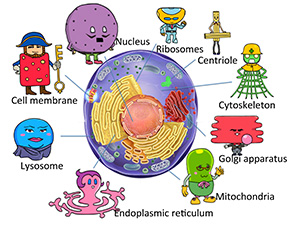Nagoya City Science Museum
TOP > Exhibition Guide > Floor Map> Republic of the Cell
Republic of the Cell

Purpose of Exhibition
The cell is the basic unit of organisms. Within a cell is a lineup of "Cell Organelles", which takes in nutrition, performs respiration, produces energy, carries out various life activities, and provide mechanisms for cell division. In the "Republic of the cell" exhibit, the cell is compared to a republic and the cell organelles, which handle various functions, to the cabinet ministers, who each introduce themselves. The purpose of this exhibit is for you to have the image of these cabinet ministers (organelles) working dynamically inside of the cell.


Additional Knowledge
The Englishman Robert Hook observed a slice of the plant cork with a microscope and discovered that it had many objects like small rooms. In his book "Micrographia (1665) ", he named them cells. After that, in 1838 Matthias Jakob Schleiden announced that the cell was the basic unit in plants and the next year, in 1839, Schwann announced this for animals. After that, it was discovered that ova and sperm are also cells and that cell division is the method with which they increase. In 1858, Rudolf Ludwig Karl Virchow made his famous pronouncement that "All Cells Come from Cells". This idea that "the Basic Unit of the Structure and Functions of Organisms is the Cell" is the "Cell Theory" and became the foundation of modern biology. From the second half of the 19th century into the first half of the 20th century, optical microscopes were improved, specimen production method and dyeing methods were developed, and various cells were researched directly and in detail. From around 1930, electron microscopes and cell fraction method were put into practical use and cell membrane and intra-cellular researched moved forward rapidly and the dynamic conditions of cell organelles came to be understood.
In the video in this exhibit, there is a scene in which a mitochondria (the Minister of Energy) is moved to sad tears. This shows the "Endosymbiotic theory" that in the first stage of cell evolution, the mitochondria was a bacteria that lived independently and at a certain point in time, it was incorporated into the cells of eukaryotes*. The reason for this is that the mitochondria is about the same size in almost all bacteria and the inner one of double membrane around it also resembles the membrane of bacteria. The mitochondria has its own DNA. When it multiples within a cell, it divides and reproduces its DNA with almost the same method as cell's nucleus. It is thought that through its coexistence within the eukaryote cells as its host, oxygen-based metabolism occurred and the capacity for energy production increased dramatically. It is thought that the chloroplasts that plant cells have were also once separate bacteria that were incorporated into plant cells, where they coexist with the cells.
* The types of cells in republic of the cell are "Eukaryotes", whose DNA is enclosed in the nuclear membrane. The cells of bacteria and archaea have no nuclear membrane and are called prokaryotes.
Article by Chieko Ozaka,curator
